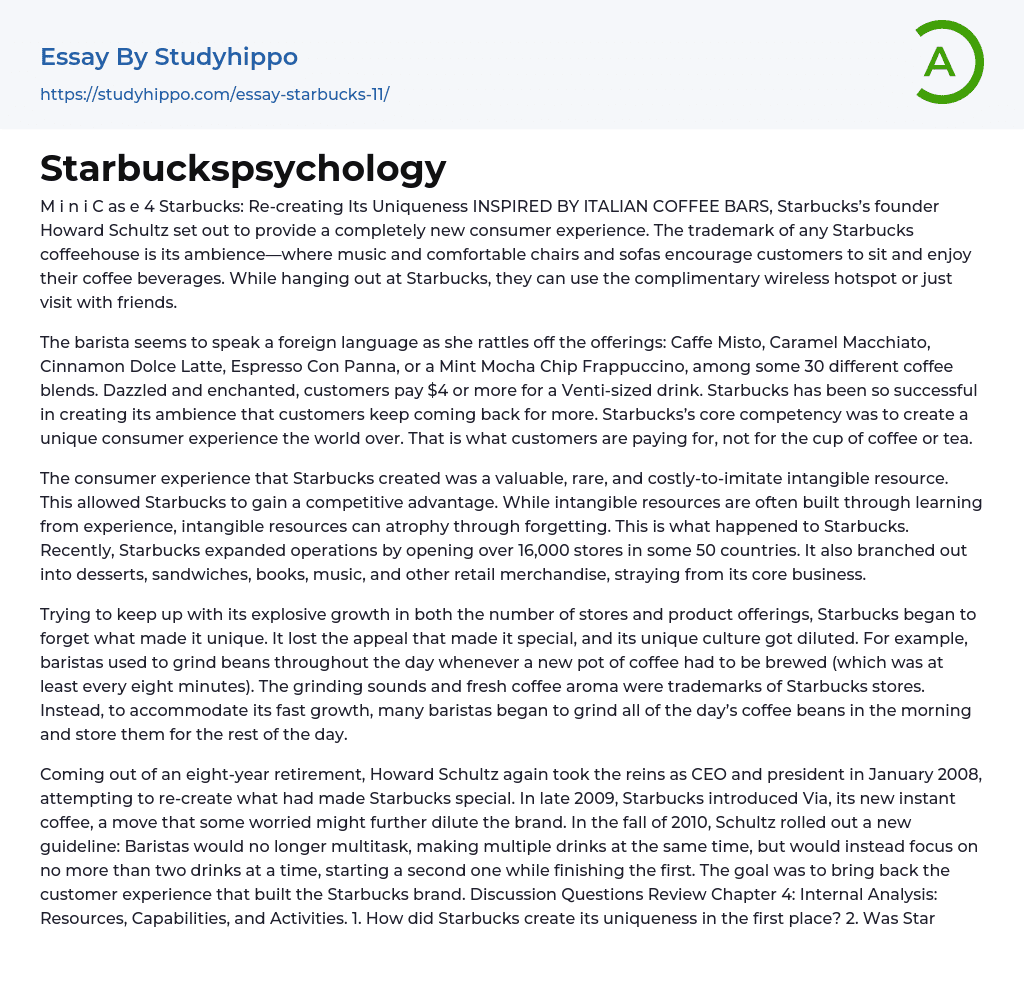Starbucks’s founder Howard Schultz set out to provide a completely new consumer experience. The trademark of any Starbucks coffeehouse is its ambience—where music and comfortable chairs and sofas encourage customers to sit and enjoy their coffee beverages. While hanging out at Starbucks, they can use the complimentary wireless hotspot or just visit with friends.
The barista seems to speak a foreign language as she rattles off the offerings: Caffe Misto, Caramel Macchiato, Cinnamon Dolce Latte, Espresso Con Panna, or a Mint Mocha Chip Frappuccino, among some 30 different coffee blends. Dazzled and enchanted, customers pay $4 or more for a Venti-sized drink. Starbucks has been so successful in creating its ambience that customers keep coming back for more. Starbucks’s core competency was to create a unique consumer experience the world over. That is what customers ar
...e paying for, not for the cup of coffee or tea.
The consumer experience that Starbucks created was a valuable, rare, and costly-to-imitate intangible resource. This allowed Starbucks to gain a competitive advantage. While intangible resources are often built through learning from experience, intangible resources can atrophy through forgetting. This is what happened to Starbucks. Recently, Starbucks expanded operations by opening over 16,000 stores in some 50 countries. It also branched out into desserts, sandwiches, books, music, and other retail merchandise, straying from its core business.
Trying to keep up with its explosive growth in both the number of stores and product offerings, Starbucks began to forget what made it unique. It lost the appeal that made it special, and its unique culture got diluted. For example, baristas used to grind beans throughout the da
whenever a new pot of coffee had to be brewed (which was at least every eight minutes). The grinding sounds and fresh coffee aroma were trademarks of Starbucks stores. Instead, to accommodate its fast growth, many baristas began to grind all of the day’s coffee beans in the morning and store them for the rest of the day.
Coming out of an eight-year retirement, Howard Schultz again took the reins as CEO and president in January 2008, attempting to re-create what had made Starbucks special. In late 2009, Starbucks introduced Via, its new instant coffee, a move that some worried might further dilute the brand. In the fall of 2010, Schultz rolled out a new guideline: Baristas would no longer multitask, making multiple drinks at the same time, but would instead focus on no more than two drinks at a time, starting a second one while finishing the first. The goal was to bring back the customer experience that built the Starbucks brand.
- Abnormal Psychology essays
- Social Psychology essays
- Developmental Psychology essays
- Jean Piaget essays
- Positive Psychology essays
- Classical Conditioning essays
- Counseling essays
- Psychoanalysis essays
- Educational Psychology essays
- Behaviorism essays
- Authority essays
- Operant Conditioning essays
- Maslow's Hierarchy Of Needs essays
- Mental Health essays
- Personality Psychology essays
- Psychotherapy essays
- Family Therapy essays
- Stanford Prison Experiment essays
- Abraham Maslow essays
- Erik Erikson essays
- Cognitive Psychology essays
- Sigmund Freud essays
- Attachment Theory essays
- Supersize Me essays
- Individual essays
- Infant essays
- Childhood essays
- Adolescence essays
- Growth Mindset essays
- Is Google Making Us Stupid essays
- Childhood Memory essays
- Positive Attitude essays
- Reinforcement essays
- Archetype essays
- Maturity essays
- Deception essays
- Certainty essays
- Conformity essays
- Aggression essays
- Behavior essays
- Human Behavior essays
- Obedience essays
- Adult essays
- Procrastination essays
- Morality essays
- Altruism essays
- Human Sexuality essays
- Role Model essays
- Perseverance essays
- Expressive essays




